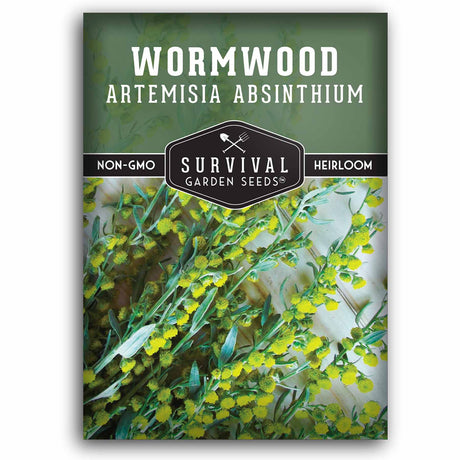Survival Garden Seeds offers heirloom Wormwood seeds, selected for their high germination rates. The package includes detailed instructions for sowing and caring, making it convenient for anyone to enjoy growing this unique herb.
Growing Wormwood Seeds in Your Garden
- Hardy aromatic herb
- Perennial, easy to grow plant
- Heirloom, non-GMO seeds
- Medicinal properties, repellent for pests
INTRODUCING WORMWOOD SEEDS
Wormwood is scientifically called Artemisia absinthium. This is a perennial plant, originating from regions of Asia, Europe, and North parts of Africa. These days, it is grown all over the world. Wormwood herb grows successfully in USDA hardiness zones 4 to 9, usually reaching 3 to 4 feet in height. With finely divided leaves and small yellow flowers, this herb is known for its bitter taste and potent medicinal properties. Often used in herbal remedies, it is mostly recognized as a key ingredient in absinthe production. NOTE: fresh wormwood does contain the plant compound thujone which can be toxic and cause hallucinations or seizures in large amounts. Consult with an expert for advice on using wormwood as a medicinal herb, as overdosing can cause serious side effects.
GROWING WORMWOOD
Start Wormwood seeds indoors, 8 to 10 weeks prior to the last frost. Sow seeds on the soil surface and press them lightly into the soil. Moist the soil regularly, until the germination process begins. Keep the temperature between 65 and 70° F during this time. In two to three weeks, the seeds will start to sprout. When seedlings grow a second set of true leaves, you may transplant them outdoors. Space the plants 18 to 24 inches apart.
MAINTAINING WORMWOOD PLANTS
Once rooted, a Wormwood plant requires very little maintenance and can become invasive if not well maintained. Water the plants sparingly. Allow the soil to dry out before each watering. They are tolerant to drought. Adding mulch at the base of the plant will be beneficial by promoting soil moisture and suppressing weeds. Wormwood enjoys occasional pruning to maintain its shape and promote bushier growth. Growing in containers is highly advised due to Wormwood’s aggressive nature. Harvest in late summer before the leaves and flowers reach full bloom as this is when the plant has the most potent medicinal properties.
Growing Wormwood in your garden will have many benefits, including aromatic foliage, medicinal uses, and natural pest-repellent properties. This hardy plant can also be used in many herbal preparations. It is a versatile herbal garden perennial.















